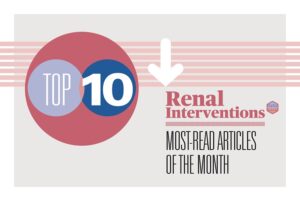 The month of March brought PAVE-2 updates, preservation debates and an assessment of the best options in marginal veins. A series of transplant updates, meanwhile, examined the need for pre-emptive living donor kidney transplantation as well as the heightened risks for female recipients of male-donor kidneys.
The month of March brought PAVE-2 updates, preservation debates and an assessment of the best options in marginal veins. A series of transplant updates, meanwhile, examined the need for pre-emptive living donor kidney transplantation as well as the heightened risks for female recipients of male-donor kidneys.
Saravanan Balamuthusamy (PPG Healthcare, Fort Worth, USA) writes to assess recent evidence on the contribution that can be made to vascular access for dialysis by machine learning algorithms, including prediction of reintervention and the mitigation of costs.
A new study in the Journal of Vascular Access (JVA) has found that, while arteriovenous fistulas (AVFs) that do not require assistance to mature have the best outcomes in the long term, unassisted arteriovenous grafts (AVGs) demonstrate better outcomes than assisted AVFs. The investigation was led by Muhammad Saad Hafeez (University of Pittsburgh Medical Center, Pittsburgh, USA).
The Saturday morning session of the American Society of Diagnostic and Interventional Nephrology (ASDIN) 19th Annual Scientific Meeting (17–19 February, Orlando, USA) played host to a stimulating debate between Edgar Lerma (University of Illinois at Chicago, Chicago, USA) and Loay Salman (Albany Medical Center, Albany, USA), the question: should an asymptomatic high-flow AVF be ligated or preserved in a patient who has received a transplant and ended dialysis?
Living-donor kidney transplantation should be “treatment of choice” over deceased-donor transplantation, owing to it being the “most secure way to achieve pre-emptive kidney transplantation”. That is the view of a group of doctors writing in Frontiers in Public Health, who argue that, given ongoing shortages of donor kidneys, deceased-donor transplantation may be a suboptimal solution that is more difficult to time appropriately, often occurring too early or too late relative to the onset of end-stage kidney disease (ESKD).
It was not just presentation sessions that featured during the Sunday morning of the ASDIN 2023 meeting. Among the several hands-on elements of the conference were tutorials on the “one-minute check” for dialysis access—explained by Debroah Brouwer-Maier (Transonic, Ithaca, USA)—as well as a cannulation simulator, illuminated by Joseph Ravi Singapogu (Clemson University, Clemson, USA).
Michael Robson and Narayan Karunanithy (King’s College London, London, UK) write to explore the range of options in drug-coated balloons (DCBs) for stenosis in AVFs. Highlighting the upcoming PAVE-2 trial, they assess the evidence from a range of studies.
In one of the select presentations at ASDIN 2023 to receive a mid-lecture round of applause, Victoria Teodorescu, associate professor of vascular surgery at Emory University (Atlanta, USA), posed the question: should nephrologists create surgical arteriovenous fistulas (sAVFs)? The rapturous response came as she answered in the affirmative.
Randomised controlled trials (RCTs) are often considered the “gold standard” of evidence on which to base clinical decision-making, but, asked Theodore Saad (Sidney Kimmel Medical College, Philadelphia, USA) at ASDIN 2023, can they be “fool’s gold”? Meanwhile, Renal Interventions spoke to Gerald Beathard (University of Texas Medical Branch, Galveston, USA) on the future of interventional nephrology.
A new Kidney International-published multinational cohort study has found that the excess risk of mortality for women who receive a kidney transplant is greater than for men when the donor is male—though not to a statistically significant degree if the donor is female. The differences were found for recipients aged 0–44 years and those over 60 years.
A study in Urologic Oncology led by Mario Ochoa-Arvizo (University of Edinburgh, Edinburgh, UK) has found that partial nephrectomy is less likely to result in new-onset postoperative CKD than radical nephrectomy. The systematic literature review and meta-analysis did not, however, find that it provided significant additional protection against advanced CKD or end-stage renal disease (ESRD).












